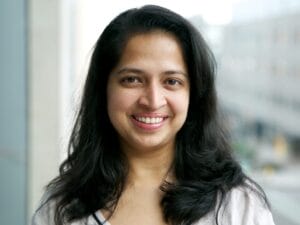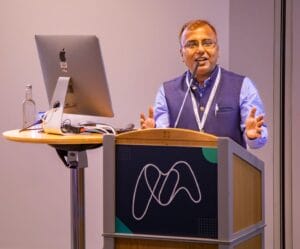Editor’s note: This is the second in a series of profiles of former faculty, staff and student workers at ASU’s Biodesign Institute in celebration of its 20th anniversary. Read the first story in this series.
For college students who want to pursue careers in science, working in a research laboratory offers invaluable experience. Not only do students get to practice the lab or analytic techniques they learn about in the classroom, but they gain sought-after skills for working on diverse science teams, such as collaboration, communication and project management.
Researchers in Arizona State University’s Biodesign Institute take inspiration from nature’s design rules to develop solutions to some of our most pressing challenges. Each year, several hundred undergraduate and graduate students join their ranks, learning from the institute’s uniquely interdisciplinary and collaborative culture. In addition, about 50 postdoctoral scholars continue their training there.
Here, two former student researchers and a postdoctoral research associate share their experience of working at Biodesign and how it shaped their current careers.
The freedom to ask questions

Krupa Navalkar, ’14 PhD in biological design — graduate researcher, 2008–14
Krupa Navalkar, a member of the first cohort of ASU’s biological design PhD program, was a graduate researcher in the Biodesign Center for Innovations in Medicine. She graduated in 2014 and is now director of bioinformatics at Immunexpress in Seattle.
“We're a sepsis diagnostics company with the first gene expression based, host response sepsis diagnostic that is FDA-cleared. It’s currently being rolled out into hospitals in the U.S. and Europe,” she says. “Every year over 11 million people die of sepsis. The prospect of launching a diagnostic assay that might reduce the number of lives lost to a disease that is treatable if detected in a timely manner is what’s most fulfilling about my work.”
Navalkar’s role at Biodesign was the ideal preparation for her current job. She worked with
Phillip Stafford, Stephen Johnston, Kathryn Sykes and Mitch Magee, developing infectious disease diagnostics using the immunosignatures peptide microarray platform. One project involved developing an immunosignature-based diagnostic for Valley fever, a serious and often misdiagnosed fungal infection common in the Southwest. Navalkar was the lead author of a study describing the new strategy, published in the journal ASM Clinical and Vaccine Immunology.
She says the lab group, at 40 members, was large, but “very close-knit.” And the group was empowered to be successful.
“I had the freedom to ask questions without fear or apprehension, just out of pure scientific inquiry. No matter how obtuse the question was that we were answering together as a team, our PIs would give us the tools to help solve those riddles,” says Navalkar, adding that the Biodesign Institute “has people with a growth mindset you don't always see elsewhere in the world.”
As gratifying as her work was within Biodesign’s walls, Navalkar’s favorite memory is from when the outside world came in.
“The first year that Biodesign was part of ASU’s ‘Open Door’ event, over 1,000 people visited the institute to talk to the students and researchers, trying to understand what we do and why. It was fun trying to teach 6-year-old kids about clustering or physician diagnosis, seeing a spark in their eyes with the thought that they could do this someday.”
In fact, a similar encounter led to Navalkar’s own career choices.
“When I was about 6 years old, I had a conversation with my family physician about how doctors know which medicines to prescribe to the patients who come into the hospital. He said, ‘They know from researchers.’ And that made me want to become a scientist, to enable better diagnosis,” she says.
Navalkar says her time at Biodesign was integral to achieving that goal.
“Being in an institution where no one judges you for your background, or the color of your skin, or your ability to communicate contributed to a stress-free environment where your only focus was research, and where simple conversations could lead to collaborations and solutions,” she says.
Working with a fantastic team
Arindam Mitra, ’08 PhD in microbiology, University of Maryland at College Park — postdoctoral research associate, 2008-12

Arindam Mitra is a professor and head of the Department of Biological Sciences at Adamas University in Kolkata, West Bengal, India. He lists his duties as teaching, research, academic administration and “working with a fantastic team in a productive manner.” “Fantastic team” is also how Mitra describes the lab associates he collaborated with as a postdoctoral researcher at the Biodesign Institute.
“I worked in the lab of Roy Curtiss III in the Center for Infectious Diseases and Vaccinology,” Mitra says. “My major responsibility was to develop a live attenuated Salmonella gallinarum vaccine for the poultry industry, and I was also involved in developing other veterinary vaccines.”
Mitra says a typical workday was pure research: designing and executing experiments, analyzing results and summarizing the findings, though he also found time to coordinate the CIDV Journal Club.
“Training at Biodesign was crucial in developing skills that helped later in my career,” Mitra says. “Working in a dynamic and collaborative environment has helped me perform better in a similar environment. I learned a lot from colleagues outside my field, which broadened my perspectives about the interdisciplinary nature of science and working in a team.”
Mitra’s work in the lab was important to populations that depend on poultry for daily nutrition and income. Salmonella gallinarum causes fowl typhoid, a widespread and devastating illness that kills between 10 and 100 percent of birds in immunocompromised flocks, such as those in developing areas.
“We developed several live attenuated vaccine candidates and also developed a poultry model to test the efficacy of vaccine candidates,” Mitra says. “My favorite memory is the day we found that some of the mutants we developed were both safe and provided high levels of protection.”
Today, Mitra collaborates with U.S. educators through professional development programs such as OCELOTS and BioGraphI to create open educational resources for biology students majoring in microbiology and biochemistry. And he shares what he’s learned during his career not only not only with his Adamas University students, but across the ocean at the New York Academy of Sciences, where he mentors students in the STEM Scholar Program. Mitra is also a Champion of the Microbiology Society in the UK and regularly organizes programs engaging Adamas students with the society.
“Teaching and training the next generation of students and learners is a way of giving back to society,” he says. “My long-term goals are to foster a dynamic and collaborative learning environment for students, enhance the quality of education and research, and promote the impact and relevance of microbiology in society.”
An uplifting and inspiring community
Grace Morgan, ’22, BS in biomedical engineering — undergraduate researcher, 2019–22

Grace Morgan became a student researcher in the Biodesign Center for Environmental Health Engineering in October 2019 to work on wastewater and soil projects led by Kerry Hamilton. There, she gained a plethora of technical skills, including modeling projects in R and Python for collaborative research supported by the Water Research Foundation — work that had to be performed remotely from March through August while the ASU campuses were closed due to COVID-19.
Back on campus, Morgan worked in the laboratory processing samples with filtration, qPCR, nanodrop, PCR robotics and other related equipment. She also collaborated with the USDA and Rebecca Muenich’s laboratory in ISTB4, where she built and ran a soil column with a fraction collector.
While she worked with many kinds of equipment and tools, Morgan remembers the people she worked with most fondly. When she first started working in Hamilton’s lab, the team was very small.
“There were only two PhD students in the lab, and the three of us would all squeeze into the one cubicle to work. There was another desk I could work at further away, but we all enjoyed randomly chatting and drinking tea while we worked, so we chose to huddle together,” she recalls.
Over time, the staff expanded from three members to more than 10, and the expansion only made things better.
“My team at Biodesign was extremely welcoming and supportive throughout my entire experience, and I had a great network of colleagues in the EHE department,” she says, recalling “an immense amount of teamwork that allowed for protocols to be developed faster, new ideas to be created, solutions workshopped and a broader network allowing for more subject matter experts.”
Morgan graduated in spring 2022 and is now a scientific affairs associate specialist for West Pharmaceutical Services. She works remotely out of Austin, Texas, helping supervise projects and external content reviews — work she was well prepared for by her time at Biodesign.
“I'm proudest of my work contributing to a large-scale literature review,” Morgan says. “I started on that project, and over my three years at Biodesign I became a pro with Zotero, working with over 20,000 references.”
When she enrolled at ASU, Morgan chose the biomedical engineering degree program, motivated by the desire to be in a position to communicate science.
“My current work fulfills me by allowing me to work with individuals across our organization and across the globe,” she says. “My time at Biodesign taught me how to collaborate with others and successfully accomplish goals while maintaining timelines.”
“I truly value my time with Biodesign,” Morgan adds. “The community is uplifting and inspiring across so many different fields!”
